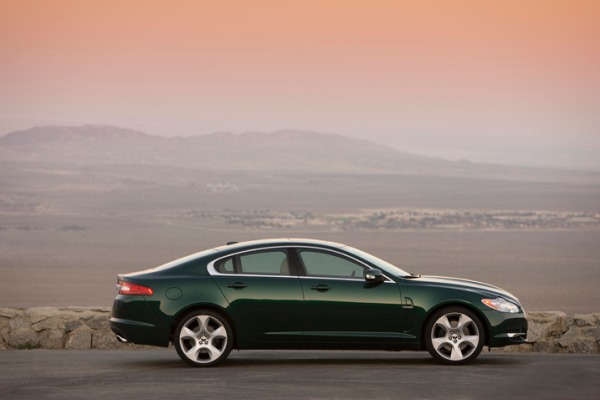
The Jaguar XF was a pivotal vehicle for the British automaker when it hit the street and showrooms in 2008, and its bold design is credited with helping breathe new life into the Coventry crew. It's also the car that Jag chose to debut a sound system from fellow Brits Bowers & Wilkins. B&W's loudspeakers are known as much for their striking visual design (namely the Nautilus series) as their stunning sound, making it a perfect fit for the new face of Jag.
But good looks only go so far in autos and audio; the proof is in the performance. And while the B&W system in the Jaguar XF is acceptable by overall OEM standards, it doesn't cut it when compared to other systems in its class, as I discovered last year when testing six high-end sound systems side-by-side for our sister site Edmunds.com -- and it finished last. Hit the jump to read how a reevaluation of an identical system in a 2010 Jaguar Premium turned out.
The System
The optional $1,875 B&W system in the 2010 Jaguar XF Premium consists of 14 speakers powered by 440 watts feeding 11 channels. The speakers include a 1-inch tweeter, 4-inch midrange and 6.5-inch woofer in each front door; another 4-inch mid in the center of the dash; a 1-inch tweeter and 6.5-inch woofer in each rear door; a 4-inch mid on each end of the rear deck; and a 7.5-inch subwoofer in an enclosure under the spare tire in the trunk.
The Sound
As with every car audio system I evaluate, critical listening is done using a dozen music tracks that I've heard in hundreds of vehicles in order to judge clarity/lack of distortion, tonal balance, timbre, tonal accuracy, soundstaging, imaging and dynamics. I also use non-audio tracks to test for imaging and staging, linearity and absence of noise. For more details on the testing process and the tracks used, check out the Edmunds.com article Sound Advice.
The B&W system in the XF is a major improvement over previous Alpine premium audio systems in Jaguar vehicles, and Jag and B&W obviously went to great lengths to make the system look and sound great. They accomplished the first goal, but fell short on the second.
One of the biggest drawbacks is the bass response of the B&W system. With our test tracks it was mainly too boomy and distorted. And even when the over-emphasized low and midbass weren't out of balance with the rest of the frequency spectrum, the deepest notes had an almost muted impact. The depth-charge low-bass throb that kicks off the track "In Your Eyes" from Joan Armatrading's What's Inside CD was uncharacteristically weak, while the in-your-face bass of Outkast's "Ain't No Thang" was likewise lackluster.
The system also had trouble faithfully reproducing the tougher treble parts of the test tracks. The Red House Painters' "Cabezon" and Luka Bloom's "Cold Comfort" both have high-pitched acoustic guitar parts that on subpar systems sound overly bright, which was the case here.
Another big knock against the B&W system was that with some tracks the music sounded downright dull. "The Blues Walk," a two-minute-plus instrumental jazz jam from Lyle Lovett and His Large Band, has well-recorded and very dynamic sax, drum, piano and guitar sounds, but the B&W system failed to bring them fully to life. Ditto for details in some of the Joan Armatrading tracks: acoustic guitars in "Merchant of Love" and "Everyday Boy" had a low-resolution quality, while vocals were veiled sounding.
Soundstaging was very good -- dash height, a bit wider than the car interior and deep. Imaging was also largely accurate, provided the system was set to three-channel mode. The two-channel mode setting seemingly defeats the center speaker and pushes center images left and right so that they are side-biased. A third Dolby ProLogic II mode expands the soundstage and also helps stabilize imaging, but at the cost of producing a processed, unnatural sound.
These soundstage and imaging impressions with music tracks were confirmed with the non-music tracks. With all but the three-channel mode engaged, the system failed the imaging tests, which consists of spoken voices mixed far left, far right and center, and seven snare-drum beats that ideally march across the dash at precise intervals. The system scored fair (out of a possibly rating of poor, fair, good and excellent) in a test of low-level linearity and good for the mid-level linearity, which gauges the musical detail that remains at low and mid volume levels.
The Sources
The 2010 Jaguar XF Premium comes with a 6-disc in-dash CD changer that offers AM, FM and Sirius satellite radio. In the center console are separate ports for USB, aux-in and iPod integration (the latter through a proprietary cable hook-up). Accessing music on either an iPod or a USB drive is straightforward and intuitive thanks to the XF's in-dash touch screen. But even this is easily outdone by systems like Ford's Sync that let you call up music via voice control.
What We Say
If this review makes it seem as if there's nothing to like about the B&W system in the 2010 Jaguar XF Premium, that's being too harsh. Especially since I've used B&W speakers in my home systems for years and love them. The system is certainly well above average compared to the majority of premium OEM audio offerings available. But for one that costs almost two grand -- and in a vehicle with a sticker price of almost $63k -- it doesn't cut it by the class-leading standards from the likes of Mark Levinson, ELS and Bang & Olufsen.
The Scores
Sound: C-
Source Selection: B-
iPod Integration: B
Cost: C